The following products can be purchased via other third party organisations e.g. TTS, Hope Education, Amazon etc. Booklets produced by Psychology4Learning Educational Psychologists can be downloaded from our website for a small fee.
-
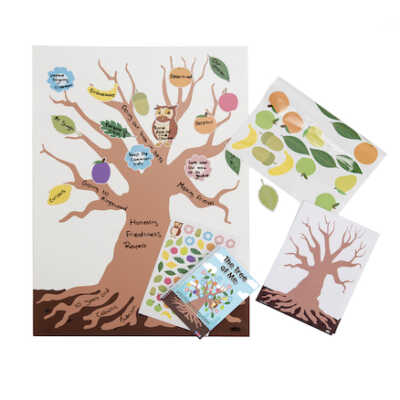 by Educational Psychologist Dr Paula Williams and TTS
by Educational Psychologist Dr Paula Williams and TTSA hard-wearing classroom display, sticker pack and teacher's guide to introduce the Tree of Me to your classroom.
The Tree of Me has been designed to help build children’s sense of identity and belonging and to help them realise the type of person they want to be.
Each part of the tree has two lesson plans, split into 'A' and 'B'. Lesson 'A' introduces the idea of what each part of the tree represents and encourages children to think about how it applies to the whole class (Tree of Us). In lesson 'B', children consider the same ideas, but as individuals (Tree of Me). Refill pack contains: 1 x 'Tree of Me' Flip Book (30 Sheets, A3) and 30 x Set of 'Tree of Me' Stickers (A3) so the resource can be used again and again. Written by Dr Paula Williams, Educational Psychologist. Difference parts of the tree has a different meaning: The Roots - where you come from: home town; country; your heritage; culture; languages that have been important; any early positive experiences, people or places. The Ground - Where you are NOW; things you choose to do on a weekly basis. The Trunk - Your skills and values. The Branches - Your hopes, dreams, and wishes. These can be long and short term. The Leaves - The names of those who are important to you in a positive way. Your friends, family, pets, heroes, etc. The Flowers - Things you can give to people or things you do, acts of kindness, entertaining, teaching. The Fruits - Things that have been given to you, being nurtured and loved; work-ethic; sense of humour; sportiness. A special thank you to Beverley Smalley, TTS Education Consultant for being the co-author on the lesson plans.
-
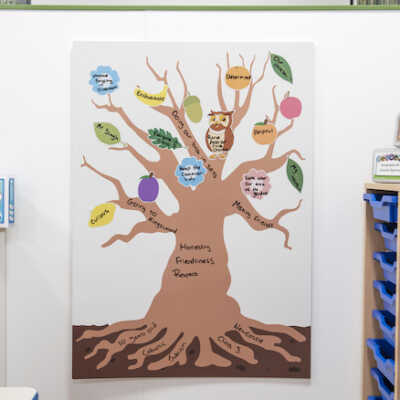 by Educational Psychologist Dr Paula Williams and TTS
by Educational Psychologist Dr Paula Williams and TTSA hard-wearing classroom display, sticker pack and teacher's guide to introduce the Tree of Me to your classroom.
The Tree of Me has been designed to help build children’s sense of identity and belonging and to help them realise the type of person they want to be.
Each part of the tree has two lesson plans, split into 'A' and 'B'. Lesson 'A' introduces the idea of what each part of the tree represents and encourages children to think about how it applies to the whole class (Tree of Us). In lesson 'B', children consider the same ideas, but as individuals (Tree of Me). Refill pack contains: 1 x 'Tree of Me' Flip Book (30 Sheets, A3) and 30 x Set of 'Tree of Me' Stickers (A3) so the resource can be used again and again. Written by Dr Paula Williams, Educational Psychologist. Difference parts of the tree has a different meaning: The Roots - where you come from: home town; country; your heritage; culture; languages that have been important; any early positive experiences, people or places. The Ground - Where you are NOW; things you choose to do on a weekly basis. The Trunk - Your skills and values. The Branches - Your hopes, dreams, and wishes. These can be long and short term. The Leaves - The names of those who are important to you in a positive way. Your friends, family, pets, heroes, etc. The Flowers - Things you can give to people or things you do, acts of kindness, entertaining, teaching. The Fruits - Things that have been given to you, being nurtured and loved; work-ethic; sense of humour; sportiness. A special thank you to Beverley Smalley, TTS Education Consultant for being the co-author on the lesson plans.
-
 by Educational Psychologist Dr Paula Williams and TTS
by Educational Psychologist Dr Paula Williams and TTSA hard-wearing classroom display, sticker pack and teacher's guide to introduce the Tree of Me to your classroom.
The Tree of Me has been designed to help build children’s sense of identity and belonging and to help them realise the type of person they want to be.
Each part of the tree has two lesson plans, split into 'A' and 'B'. Lesson 'A' introduces the idea of what each part of the tree represents and encourages children to think about how it applies to the whole class (Tree of Us). In lesson 'B', children consider the same ideas, but as individuals (Tree of Me). Refill pack contains: 1 x 'Tree of Me' Flip Book (30 Sheets, A3) and 30 x Set of 'Tree of Me' Stickers (A3) so the resource can be used again and again. Written by Dr Paula Williams, Educational Psychologist. Difference parts of the tree has a different meaning: The Roots - where you come from: home town; country; your heritage; culture; languages that have been important; any early positive experiences, people or places. The Ground - Where you are NOW; things you choose to do on a weekly basis. The Trunk - Your skills and values. The Branches - Your hopes, dreams, and wishes. These can be long and short term. The Leaves - The names of those who are important to you in a positive way. Your friends, family, pets, heroes, etc. The Flowers - Things you can give to people or things you do, acts of kindness, entertaining, teaching. The Fruits - Things that have been given to you, being nurtured and loved; work-ethic; sense of humour; sportiness. A special thank you to Beverley Smalley, TTS Education Consultant for being the co-author on the lesson plans.
-
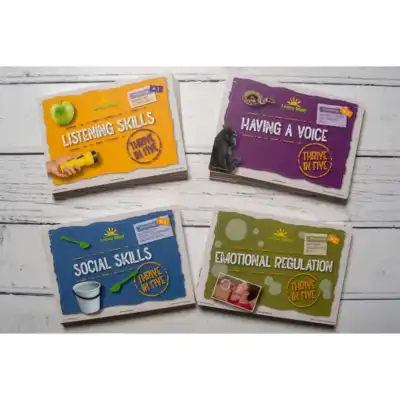 by Educational Psychologists Dr Paula Williams, Sharon Evans, Dr Julia Crane, and Hope Education Thrive in Five is a collection of short, easy-to-do activities that support children’s social, emotional and communication skills in a fun and active way. Created by three Educational Psychologists for children at Foundation Stage, Key Stage 1, or older children with additional needs. Each activity takes 5-10 minutes and can be used as a ‘warm up’ or ‘time filler’ when a short activity is needed. The perfect grab and go! From blowing up imaginary balloons to becoming a sound detective, children will love them all. Each set contains 20 activity cards.
by Educational Psychologists Dr Paula Williams, Sharon Evans, Dr Julia Crane, and Hope Education Thrive in Five is a collection of short, easy-to-do activities that support children’s social, emotional and communication skills in a fun and active way. Created by three Educational Psychologists for children at Foundation Stage, Key Stage 1, or older children with additional needs. Each activity takes 5-10 minutes and can be used as a ‘warm up’ or ‘time filler’ when a short activity is needed. The perfect grab and go! From blowing up imaginary balloons to becoming a sound detective, children will love them all. Each set contains 20 activity cards.- Thrive in Five Set 1 – Listening Skills
- Thrive in Five Set 2 – Having a Voice
- Thrive in Five Set 3 – Emotional Regulation
- Thrive in Five Set 4 – Social Skills
-
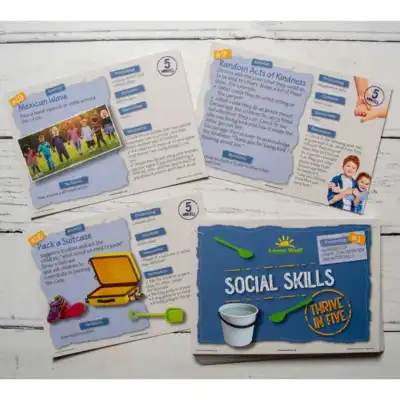 by Educational Psychologists Dr Paula Williams, Sharon Evans, Dr Julia Crane, and Hope Education Thrive in Five is a collection of short, easy-to-do activities that support children’s social, emotional and communication skills in a fun and active way. Created by three Educational Psychologists for children at Foundation Stage, Key Stage 1, or older children with additional needs. Each activity takes 5-10 minutes and can be used as a ‘warm up’ or ‘time filler’ when a short activity is needed. The perfect grab and go! From blowing up imaginary balloons to becoming a sound detective, children will love them all. Each set contains 20 activity cards.
by Educational Psychologists Dr Paula Williams, Sharon Evans, Dr Julia Crane, and Hope Education Thrive in Five is a collection of short, easy-to-do activities that support children’s social, emotional and communication skills in a fun and active way. Created by three Educational Psychologists for children at Foundation Stage, Key Stage 1, or older children with additional needs. Each activity takes 5-10 minutes and can be used as a ‘warm up’ or ‘time filler’ when a short activity is needed. The perfect grab and go! From blowing up imaginary balloons to becoming a sound detective, children will love them all. Each set contains 20 activity cards. -
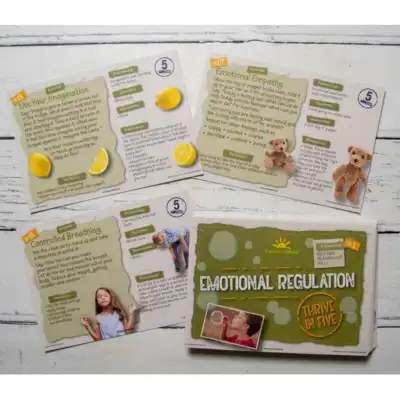 by Educational Psychologists Dr Paula Williams, Sharon Evans, Dr Julia Crane, and Hope Education Thrive in Five is a collection of short, easy-to-do activities that support children’s social, emotional and communication skills in a fun and active way. Created by three Educational Psychologists for children at Foundation Stage, Key Stage 1, or older children with additional needs. Each activity takes 5-10 minutes and can be used as a ‘warm up’ or ‘time filler’ when a short activity is needed. The perfect grab and go! From blowing up imaginary balloons to becoming a sound detective, children will love them all. Each set contains 20 activity cards.
by Educational Psychologists Dr Paula Williams, Sharon Evans, Dr Julia Crane, and Hope Education Thrive in Five is a collection of short, easy-to-do activities that support children’s social, emotional and communication skills in a fun and active way. Created by three Educational Psychologists for children at Foundation Stage, Key Stage 1, or older children with additional needs. Each activity takes 5-10 minutes and can be used as a ‘warm up’ or ‘time filler’ when a short activity is needed. The perfect grab and go! From blowing up imaginary balloons to becoming a sound detective, children will love them all. Each set contains 20 activity cards. -
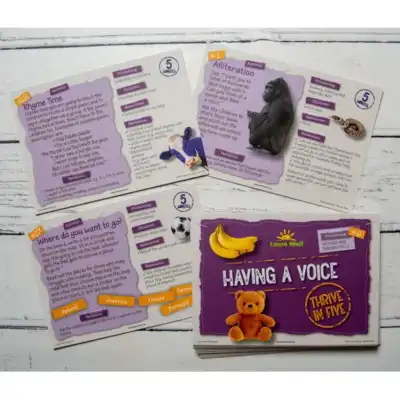 by Educational Psychologists Dr Paula Williams, Sharon Evans, Dr Julia Crane, and Hope Education Thrive in Five is a collection of short, easy-to-do activities that support children’s social, emotional and communication skills in a fun and active way. Created by three Educational Psychologists for children at Foundation Stage, Key Stage 1, or older children with additional needs. Each activity takes 5-10 minutes and can be used as a ‘warm up’ or ‘time filler’ when a short activity is needed. The perfect grab and go! From blowing up imaginary balloons to becoming a sound detective, children will love them all. Each set contains 20 activity cards.
by Educational Psychologists Dr Paula Williams, Sharon Evans, Dr Julia Crane, and Hope Education Thrive in Five is a collection of short, easy-to-do activities that support children’s social, emotional and communication skills in a fun and active way. Created by three Educational Psychologists for children at Foundation Stage, Key Stage 1, or older children with additional needs. Each activity takes 5-10 minutes and can be used as a ‘warm up’ or ‘time filler’ when a short activity is needed. The perfect grab and go! From blowing up imaginary balloons to becoming a sound detective, children will love them all. Each set contains 20 activity cards. -
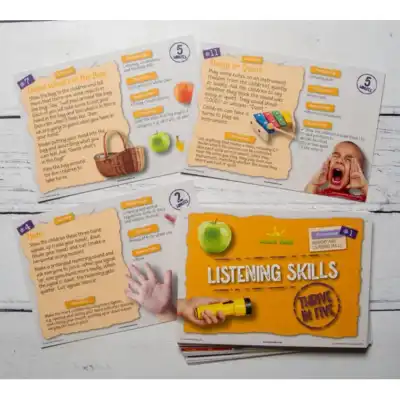 by Educational Psychologists Dr Paula Williams, Sharon Evans, Dr Julia Crane, and Hope Education Thrive in Five is a collection of short, easy-to-do activities that support children’s social, emotional and communication skills in a fun and active way. Created by three Educational Psychologists for children at Foundation Stage, Key Stage 1, or older children with additional needs. Each activity takes 5-10 minutes and can be used as a ‘warm up’ or ‘time filler’ when a short activity is needed. The perfect grab and go! From blowing up imaginary balloons to becoming a sound detective, children will love them all. Each set contains 20 activity cards.
by Educational Psychologists Dr Paula Williams, Sharon Evans, Dr Julia Crane, and Hope Education Thrive in Five is a collection of short, easy-to-do activities that support children’s social, emotional and communication skills in a fun and active way. Created by three Educational Psychologists for children at Foundation Stage, Key Stage 1, or older children with additional needs. Each activity takes 5-10 minutes and can be used as a ‘warm up’ or ‘time filler’ when a short activity is needed. The perfect grab and go! From blowing up imaginary balloons to becoming a sound detective, children will love them all. Each set contains 20 activity cards. -
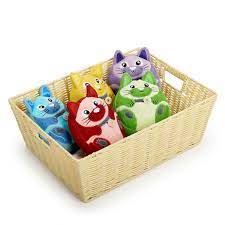 Mental Health and Wellbeing Programme by Dr Paula Williams and TTS
Mental Health and Wellbeing Programme by Dr Paula Williams and TTSCalming Kittens offers young children in early years and KS1 a toolkit to understand and manage their emotions. Through engaging strategies, children learn to calm themselves and gain better emotional self-control.
The activity cards assist practitioners, teachers and parents in discussing emotions with children. By using these tools, they can help children understand that feelings are natural and guide them in developing effective coping methods.
The materials are organised into five color-coded sections, with each kitten symbolising a calming activity: controlled breathing, singing, chanting, repetitive actions, and exercise. These activities are designed to teach children effective coping methods while ensuring they have fun. When children enjoy themselves, their bodies release oxytocin – a hormone that boosts feelings of happiness and well-being.
Designed for younger children, these smaller cat versions are easier to handle. The activities maintain the same impactful benefits as those in the original Calming Cat set.
-
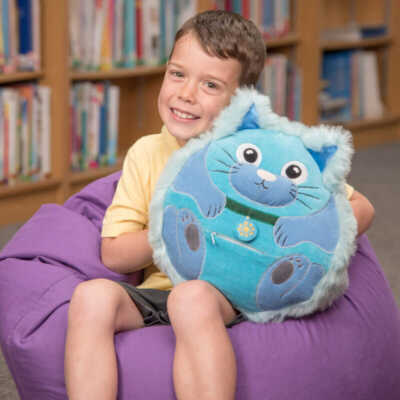 Mental Health and Wellbeing Programme by Dr Paula Williams and TTS
Mental Health and Wellbeing Programme by Dr Paula Williams and TTSOur mental health and wellbeing programme, helps children to talk about their feelings, thoughts and behaviours, as well as offering coping strategies. The engaging, huggable, tactile cat can help to facilitate conversations and can also be used as a worry aid.
Developed by Educational Psychologist Dr Paula Williams, Calming Cat and its content are designed for any child or young person, who needs to learn about their bodies reaction to feelings and how to manage them. Can be used in one to one sessions or as a whole class resource.
Contains over 140 coaching cards, giving insight, advice and activities to develop knowledge, skills and understanding, an example of them can be downloaded from our website. The appealing cat design has soft, soothing fur and a weighted body making it calming to hold. There is a tummy pocket that can be used for a personal comforting object or for a child to put a worry or concern. The openings at the side are great for little hands to cuddle the cat. Its multi-sensory materials will help keep children stimulated and calm. Perfect for younger children as a worry buddy for sharing feelings and worries. Can be used during an adult and child discussion as a comfortable communication medium for children. The calming cat worry toy is available to be purchased separately. Wipe clean with a damp cloth or antibacterial wipes.
Calming cat plush toy suitable for age range 3+, Calming cat and coaching cards suitable for age range 5+. The different coloured coaching cards will help address a variety of feelings, as well as giving greater understanding of the physiological causes and effects of emotions: Green – Knowledge – About our bodies and how we respond, Blue – Skills – Effective strategies to add to a personal resources bank, Pink – Fun – Ensure children make time for fun on a regular basis, Yellow – Understanding – Stimulate thoughts and reflection about feelings and behaviours and Grey – Warnings – Reminders to recognise when worries might be starting to appear.
-
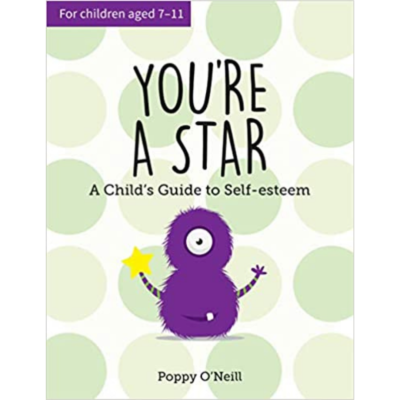 Paperback Published 8 March 2018 by Poppy O'Neill Does your child often feel isolated and do they struggle to get involved in social situations? Are they nervous about what people think of them, or maybe they’re just a little unsure of how they feel about themselves? These could be signs that your child is experiencing low self-esteem. This practical guide combines proven cognitive-behavioural therapy methods used by child psychologists in schools with simple activities to help your child grow their self-esteem. It’s aimed at children aged 7–11 because a lot happens in these years that can impact a child’s sense of self-worth, not just now but for years to come. Your child will be guided, with the help of Bop – a friendly and supportive character they can identify with – through fun and engaging activities which are interspersed with useful tips, inspirational statements and practical information for parents.
Paperback Published 8 March 2018 by Poppy O'Neill Does your child often feel isolated and do they struggle to get involved in social situations? Are they nervous about what people think of them, or maybe they’re just a little unsure of how they feel about themselves? These could be signs that your child is experiencing low self-esteem. This practical guide combines proven cognitive-behavioural therapy methods used by child psychologists in schools with simple activities to help your child grow their self-esteem. It’s aimed at children aged 7–11 because a lot happens in these years that can impact a child’s sense of self-worth, not just now but for years to come. Your child will be guided, with the help of Bop – a friendly and supportive character they can identify with – through fun and engaging activities which are interspersed with useful tips, inspirational statements and practical information for parents. -
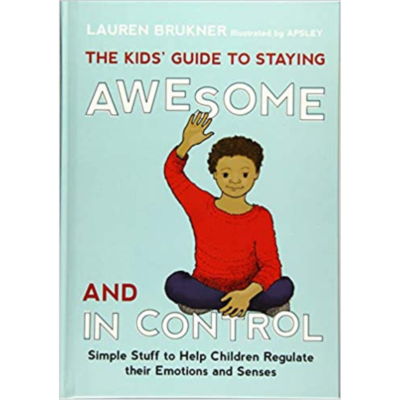 Paperback Published 22 July 2014 by Packed with simple ideas to regulate the emotions and senses, this book will help children tackle difficult feelings head-on and feel awesome and in control! From breathing exercises, pressure holds and finger pulls, to fidgets, noise-reducing headphones and gum, the book is brimming with fun stuff to help kids feel cool, calm and collected. They will learn how to label difficult feelings, choose the perfect strategies and tools to tackle them, and use these correctly whether at home or at school. The strategies and tools are accompanied by cartoon-style illustrations, and the author includes useful tips for parents and teachers as well as handy visual charts and checklists to track learning and progress. Armed with this book, kids will be well on their way to managing difficult emotions and feeling just right in whatever situation life throws at them! Suitable for children with emotional and sensory processing difficulties aged approximately 7 to 14 years.
Paperback Published 22 July 2014 by Packed with simple ideas to regulate the emotions and senses, this book will help children tackle difficult feelings head-on and feel awesome and in control! From breathing exercises, pressure holds and finger pulls, to fidgets, noise-reducing headphones and gum, the book is brimming with fun stuff to help kids feel cool, calm and collected. They will learn how to label difficult feelings, choose the perfect strategies and tools to tackle them, and use these correctly whether at home or at school. The strategies and tools are accompanied by cartoon-style illustrations, and the author includes useful tips for parents and teachers as well as handy visual charts and checklists to track learning and progress. Armed with this book, kids will be well on their way to managing difficult emotions and feeling just right in whatever situation life throws at them! Suitable for children with emotional and sensory processing difficulties aged approximately 7 to 14 years.
